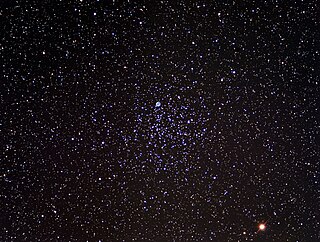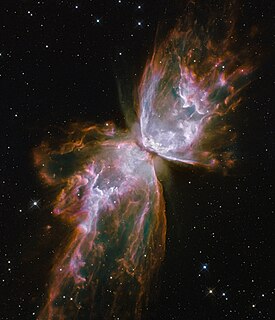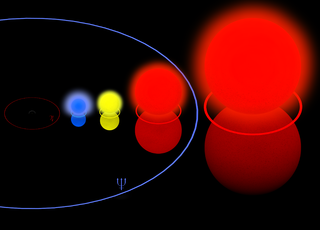
The Triangulum Galaxy is a spiral galaxy approximately 3 million light-years (ly) from Earth in the constellation Triangulum. It is catalogued as Messier 33 or NGC 598. The Triangulum Galaxy is the third-largest member of the Local Group of galaxies, behind the Milky Way and the Andromeda Galaxy. It is one of the most distant permanent objects that can be viewed with the naked eye.

An H II region or HII region is a region of interstellar atomic hydrogen that is ionized. It is typically a cloud of partially ionized gas in which star formation has recently taken place, with a size ranging from one to hundreds of light years, and density from a few to about a million particles per cubic cm. The Orion Nebula, now known to be an H II region, was observed in 1610 by Nicolas-Claude Fabri de Peiresc by telescope, the first such object discovered.

Messier 87 is a supergiant elliptical galaxy in the constellation Virgo. One of the most massive galaxies in the local Universe, it has a large population of globular clusters—about 12,000 compared with the 150–200 orbiting the Milky Way—and a jet of energetic plasma that originates at the core and extends at least 1,500 parsecs, traveling at relativistic speed. It is one of the brightest radio sources in the sky and a popular target for both amateur and professional astronomers.

The Tarantula Nebula is an H II region in the Large Magellanic Cloud (LMC).

The Calabash Nebula, also known as the Rotten Egg Nebula or by its technical name OH 231.84 +4.22, is a protoplanetary nebula (PPN) 1.4 light years long and located some 5,000 light years from Earth in the constellation Puppis. The name "Calabash Nebula" was first proposed in 1989 in an early paper on the expected nebular dynamics, based on the nebula's appearance The Calabash is an almost certain member of the open cluster Messier 46, as it has the same distance, radial velocity, and proper motion.

Messier 46 or M46, also known as NGC 2437, is an open cluster of stars in the constellation of Puppis. It was discovered by Charles Messier in 1771. Dreyer described it as "very bright, very rich, very large." M46 is about 4,920 light-years away. There are an estimated 500 stars in the cluster with a combined mass of 453 M☉, and it is thought to be some 251.2 million years old.

The Owl Nebula is a planetary nebula located approximately 2,030 light years away in the constellation Ursa Major. It was discovered by French astronomer Pierre Méchain on February 16, 1781. When William Parsons, 3rd Earl of Rosse, observed the nebula in 1848, his hand-drawn illustration resembled an owl's head. It has been known as the Owl Nebula ever since.

Messier 93 or M93, also known as NGC 2447, is an open cluster in the constellation Puppis. It was discovered by Charles Messier then added to his catalogue of comet-like objects on March 20, 1781. Caroline Herschel, the younger sister of William Herschel, independently discovered M93 in 1783, thinking it had not yet been catalogued by Messier. Walter Scott Houston described its appearance as follows:
Some observers mention the cluster as having the shape of a starfish. With a fair-sized telescope, this is its appearance on a dull night, but [a four-inch refractor] shows it as a typical star-studded galactic cluster.

NGC 6302, also called the Bug Nebula or Butterfly Nebula, is a bipolar planetary nebula in the constellation Scorpius. The structure in the nebula is among the most complex ever observed in planetary nebulae. The spectrum of NGC 6302 shows that its central star is one of the hottest stars in the galaxy, with a surface temperature in excess of 250,000 degrees Celsius, implying that the star from which it formed must have been very large.

Palomar 1 is a globular cluster in the constellation Cepheus in the halo possibly in the Outer Arm of the Milky Way galaxy. First discovered by George O. Abell in 1954 on the Palomar Survey Sky plates, it was catalogued as a globular cluster. At 6.3 to 8 Gyr, it is a very young cluster when compared to the other globular clusters in the Milky Way. It is a relatively metal-rich globular with [Fe/H] = -0.60. It is likely that Palomar 1 has a similar evolutionary history to the Sagittarius dwarf companion globular Terzan 7, that is, it may have once been associated with a dwarf spheroidal galaxy that was later destroyed by tidal forces.
2 Ursae Minoris is a single star a few degrees away from the northern celestial pole. Despite its Flamsteed designation, the star is actually located in the constellation Cepheus. This changed occurred when the constellation boundaries were formally set in 1930 by Eugene Delporte. Therefore, the star is usually referred only by its catalog numbers such as HR 285 or HD 5848. It is visible to the naked eye as a faint, orange-hued star with an apparent visual magnitude of 4.244. This object is located 280 light years away and is moving further from the Earth with a heliocentric radial velocity of +8 km/s. It is a candidate member of the Hyades Supercluster.
Iota Cephei is a solitary star in the northern constellation Cepheus. Based upon an annual parallax shift of 15.83 mas as seen from the Earth, it is located about 206 light years from the Sun. The star is visible to the naked eye with an apparent visual magnitude of 3.5.

RCW 88 is an emission nebula in the southern constellation of Circinus that first appeared in the 1960 astronomical catalogue by Rodgers, Campbell & Whiteoak (RCW) of Hα-emission regions within the southern Milky Way. Earlier observers, like James Wray in 1966, misclassified this as a likely 12.0v magnitude planetary nebula, but later spectroscopic investigations revealed this as a diffuse nebulae. RCW 88 was then to be identified by the infrared satellite IRAS as an HII region.
HD 217382 is a suspected binary star system in the northern circumpolar constellation of Cepheus. It is faintly visible to the naked eye with an apparent visual magnitude of 4.70. The distance to HD 217382 is around 319 light years, as determined from an annual parallax shift of 10.2152 mas. The system is moving further away with a heliocentric radial velocity of +2.6 km/s. It is a candidate member of the Hyades supercluster and has a peculiar velocity of 9.2 km/s.

9 Cephei, also known as V337 Cephei, is a variable star in the constellation Cepheus.
The astronomer Edward Emerson Barnard compiled a list of dark nebulae known as the Barnard Catalogue of Dark Markings in the Sky, or the Barnard Catalogue for short. The nebulae listed by Barnard have become known as Barnard objects. A 1919 version of the catalogue listed 182 nebulae; by the time of the 1927 version, it listed 369.
Gliese 809 is a red dwarf star in the constellation Cepheus, forming the primary component of a multi-star system. A visual magnitude of 8.55 makes it too faint to see with the naked eye. It is part of the Gliese Catalogue of Nearby Stars and is located about 23 light-years (ly) from the Solar System. Gliese 809 has about 70.5% the radius of the Sun and 61.4% of the Sun's mass. It has a metallicity of −0.06, which means that the abundance of elements other than hydrogen and helium is just 87.1% that of the Sun.
FL Lyrae is the variable star designation for an eclipsing binary star system in the northern constellation of Lyra. The combined apparent magnitude of the pair is 9.36, which means they are too faint to be seen with the naked eye. Parallax measurements from the Hipparcos spacecraft put the system at a distance of around 420 light years from the Sun. This star system was in the view field of the Kepler space telescope during 2009−2014, which allowed monitoring during that spacecraft's mission.

NGC 6905, also known as the Blue Flash Nebula, is a planetary nebula in the constellation Delphinus. It was discovered by William Herschel in 1784. The central star is 14.0 mag. The distance of the nebula, as with most planetary nebulae, is not well determined and estimates range between 1.7 and 2.6 kpc.
Rho2 Eridani is a star located in the constellation Eridanus. It forms an asterism with Rho1 and Rho3 Eridani, south of Cetus, in the upper north east portion of Eridanus. The star has an apparent visual magnitude of 5.32, which indicates it is visible to the naked eye on a clear, dark night. Based upon parallax measurements made with the Hipparcos satellite, this star is roughly 260 light years away from the Sun.
















